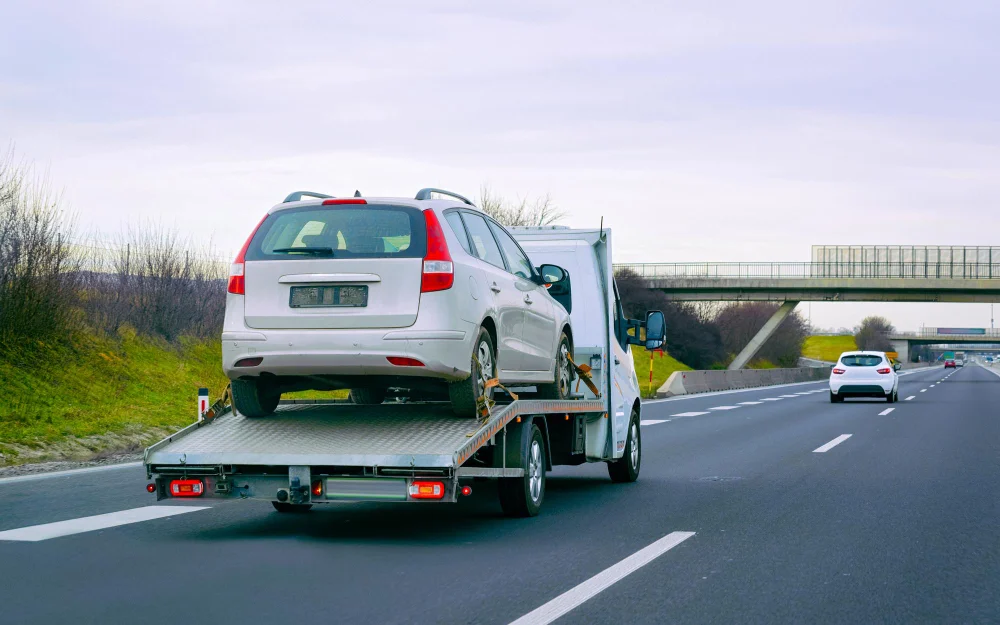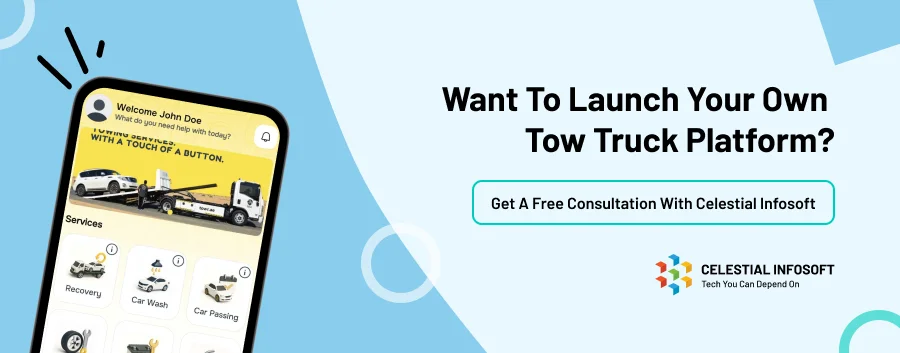
Launching a tow truck business in 2025 is smarter than ever. Demand for roadside assistance is resilient, customers expect fast, app-like experiences, and there are two legit paths to start: Own and operate your own trucks, or start a tow truck marketplace app connecting drivers to local towers.
This guide takes you through both with actual start-up expenses, step-by-step to-do lists, and marketing strategies to solve your confusion on how to start a tow truck business in 2025 easily.
Table of Contents
Why Start a Tow Truck Business in 2025, Startup Costs, Business Models, etc.
- Vehicle counts and average vehicle age remain high → breakdowns still happen.
- Customers like pay-as-you-use services with clear ETAs and online payment modes.
- Software and telematics allow an even one-truck company to operate like a pro.
Two Ways to Start (Overview)
Approach A — Own & Operate Tow Trucks: You buy or lease trucks, hire (or drive yourself), manage permits, insurance, dispatch, and service quality.
Approach B — Marketplace App: You don’t own trucks; you run a platform that matches customers to towers and earn commissions/subscriptions.
Approach A – Own & Operate Tow Trucks

How It Works
You earn from hook-up + mileage, storage (where permitted), and light roadside services (jump-starts, tire changes, lockouts, fuel delivery). Profit depends on volume, route efficiency, local rate caps, and contracts (insurers, motor clubs, dealers, property managers).
Average 2025 Startup Expenses (What to Allow)
- Tow truck (wrecker or light-duty carrier): cost spans broadly by make, chassis, deck, and upfit. New light-duty carriers typically are in the high five through low six figures; used stock can minimize upfront cost. (Request bids from approved dealers; compare financing and warranty options.)
- Licenses & permits: If you’ll be state-to-state traveling or reach federal thresholds, your business will need a USDOT number and possibly Operating Authority (MC). Local governments also usually require police/business towing permits. Always verify your requirements for your city/county.
- Insurance: Tow ops need auto liability, on-hook/cargo, garagekeepers (in the event of storing), and workers’ comp when you engage them. For comparison, Progressive references 2024 commercial truck insurance averages (dependent on use/type) in the $746–$954/month range—towing can fluctuate, so ask for a custom quote.
- Equipment & Tools: Straps, chains, dollies, PPE, cones, spill kits, lockout kit, jump box.
- Software & comms: Dispatching, GPS/ETAs, e-payments, VoIP, CRM, and basic website.
- Working capital: Fuel, tires/maintenance, payroll (in case of hiring), marketing, and buffer.
Compliance Snapshot (Know These Early)
- Federal (if necessary): USDOT & Operating Authority fundamentals (interstate travel, cargo transported). Begin from the FMCSA official guidance and register via the Unified Registration System.
- Local city rules & rate caps: Many cities publish tow rate caps and storage fees (example: NYC’s posted caps for DARP/ROTOW tows and storage). Your city will vary; check official pages.
- Police/business licenses: Some jurisdictions need a police-type license for towing services (e.g., Los Angeles). Look up your city’s police/fiscal sites to see the licensing categories and procedures.
How to Business Tow Trucks Business in the State of California
Starting a tow truck service business in the state of California requires tedious compliance with local and statewide regulations. The State of California Department of Motor Vehicles (DMV) needs a commercial vehicle operator to obtain a Motor Carrier Permit (MCP), the California Highway Patrol (CHP) regulates rotation tow programs and safety requirements, and businesses doing interstate towing require a USDOT number through the Federal Motor Carrier Safety Administration (FMCSA) Registrars.
Start-up expenses in California will be anywhere from $90,000 to $200,000+, depending on truck acquisition, insurance, licenses, and dispatch equipment. Insurance should include liability, on-hook, and garagekeepers (if you store autos in storage).
Bonus Tip: Consult reputable sources such as the California DMV MCP Program and CHP guidebooks prior to buying equipment.
California’s high vehicle population density and large traffic volume provide consistent demand. Blend compliance with strong online visibility, Google Business Profile, city-level local SEO Los Angeles/San Diego, and insurer relationships, to realize ultimate growth.
How to Start a Tow Truck Business in Florida
In Florida, tow truck businesses must register with the Florida Department of State – Division of Corporations, obtain a local business tax receipt, and follow county-specific regulations. Non-consent towing (police-initiated) is strictly controlled, especially in counties like Miami-Dade and Broward, which enforce fee caps and inspection protocols.
Startup costs in Florida typically range between $80,000 and $180,000, depending on truck type, insurance rates, and county permit requirements. Essential insurance policies include commercial liability, on-hook/cargo coverage, and workers’ compensation (if you hire staff).
Pro Tip: Visit the Florida Division of Corporations and local county webpages to ensure compliance information.
Florida’s consistent year-round driving conditions and tourist-laden areas such as Orlando and Miami produce strong towing demand. Focus on such high-traffic areas with optimized online advertising, roadside signs, and agreements with car rental companies and repair facilities.
Pricing & Revenue Basics (Consent/Non-Consent Will Vary)
- Consent tows (the client calls you) typically pay a base + by-the-mile rate, plus extras (winch time, dollies, after-hours).
- Non-consent/police/rotation tows are usually capped or contracted.
- Storage can be regulated by daily restrictions.
Example First-Month Calculation (Owner-Operator)
This is an example, not a guarantee. Fill in your local area’s rates & your truck loan.
- Jobs/month: 60 (≈2/day)
- Avg ticket: $150 (local caps/typical in-city tow)
- Revenue: 60 × $150 = $9,000
Average monthly expenses (example):
- Truck finance: ~$2,372 (e.g., $117,000 @ 8% APR, 60 months)
- Insurance: ~$800 (actual towing cost may differ)
- Fuel & maintenance: ~$1,000
- Software/phone/marketing/misc: ~$900
Owner-operated net (pre-tax): ≈ $9,000 − $5,072 = $3,928
Hire a full-time driver? Add wages/payroll burden, and your margin tightens until volume and average ticket rise (or you secure better contracts).
Step-by-Step: Launching an Owned-Truck Towing Company
- Research local rules & rates – Exfil towing caps, storage charges, rotation guidelines, and permit lists from your county/city sites. Look at official examples like NYC’s posted caps, then find your own city pages.
- Form the company & banking – Select LLC/corp, create EIN, business bank/credit, and an accounting stack (invoicing, receipts, mileage, and fuel logs).
- Federal & state registrations – If interstate or meet FMCSA thresholds, get USDOT and, if applicable, Operating Authority (MC). Intrastate-only operators should verify state requirements.
- Insurance quotations – Ensure quotes explicitly cover auto liability, on-hook/cargo, garagekeepers, and workers’ comp.
- Equipment Procurement – Start with a reliable light-duty carrier or wrecker, then add essentials: straps, chains, PPE, cones, lockout kit, jump pack, spill kit, and yard storage if allowed.
- Adopt software & telematics – Dispatch + GPS/ETAs, e-payments, dashcams, telematics for efficiency and safety.
- Generate demand through contracts – Secure relationships with insurers, motor clubs, dealerships, property managers, and fleets.
- Publish transparent pricing & ETAs – Clearly list base rates, per-mile, after-hours, winch time, and storage. Keep ETAs realistic.
- Launch, measure, adjust – Track metrics: jobs/day, on-time %, average ticket, repeat rate, reviews, cost/job, revenue/mile. Adjust operations accordingly.
Marketing Strategy for Approach A (Offline + Online)
Offline (high intent):
- Highway-side banners & yard signs with 24/7 phone and QR to Google Business Profile.
- Referral deals for body shops, hotels, apartments, and security firms.
- Fleet/auction partnerships for steady work.
Online (scalable):
- Google Business Profile: list services, service area, photos, reviews.
- Local SEO: “Emergency towing in [City]”, “Flatbed towing [Neighborhood]”.
- Search ads (call-only) during peak hours with tracking.
- Social retargeting (FB/IG) for past customers and web visitors.
Retention:
- SMS updates for ETA/invoice.
- Post-service review requests.
- Repeat promos (e.g., $10 off next service within 6 months).
Common Pitfalls (and How to Avoid Them)
- Under-insuring: Ensure coverage includes on-hook/cargo and correct limits.
- Ignoring local caps/permits: Leads to fines or lost payments; always check city rules.
- No contracts: Over-reliance on ad-hoc calls creates volatile income.
- Weak dispatch: Missed ETAs ruin reviews. Use GPS/ETAs and clear driver SOPs.
Approach B — Tow Truck Marketplace App
How the Model Functions
Instead of owning trucks, you launch a two-sided platform where:
- Customers request towing or roadside services.
- Verified local tow operators accept jobs.
- You earn through commission (e.g., 10–20%) or provider subscriptions.
This model is asset-light and scalable across multiple cities.
Average 2025 Startup Expenses
- Starter App – Single-user interface (basic towing request, payment, location share)
- Starts from $2,000 (ideal for testing the market or small local operations).
- App Development – MVP (Customer + Driver apps + Admin Panel + Payments + GPS/ETAs):
- Cross-platform MVP (Flutter/React Native): $20,000 – $40,000
- Full-featured platform with analytics, loyalty, and AI dispatch: $50,000+
- Server & Maintenance: $500 – $1,500/month (depends on users & cloud setup).
- Legal & Compliance: Terms of service, insurance policy verification, GDPR/CCPA compliance.
- Marketing & User Acquisition: $2,000 – $10,000 for the launch phase.
Step-by-Step: Creating a Marketplace App

- Define Niche & Pilot City
Focus on specifics (e.g., light-duty only, 30-minute ETAs) and pilot in one city. - Scope MVP Features
- Customer App: Request service, live tracking, payment, and reviews.
- Provider App: Accept/reject jobs, routing, earnings dashboard.
- Admin Panel: Provider verification, commission tracking, analytics, support.
- Provider Onboarding & Policies
Requires a driver’s license, insurance, and a background check.
Define SLAs for response times and dispute handling. - Launch & Marketing
- Paid ads (Google, Facebook, Instagram) targeting stranded drivers + vehicle owners.
- Partnerships with insurers & auto shops for credibility.
- Email/SMS campaigns to push app installs.
- Continuous Iteration
Weekly updates on:- Conversion rates
- ETA accuracy
- Customer satisfaction
- Fraud detection + payment success
Marketing Plan for Approach B
- Pre-launch: Build email list via landing page with early sign-up discounts.
- Post-launch:
- Run PPC ads targeting “emergency tow near me.”
- Push referral incentives for both drivers & customers.
- In-app push offers (e.g., “$10 off first tow”).
- Retention:
- Loyalty rewards (cashback points).
- Driver rating badges.
- Real-time chat support.
Cost & ROI Comparison (2025)
| Metric | Approach A: Owned Trucks | Approach B: Marketplace App |
|---|---|---|
| Initial Investment | $80,000 – $200,000+ (trucks, insurance, permits, yard) | $2,000 – $50,000 (app + marketing) |
| Scaling | Add trucks, drivers, and yard space | Add new cities & operators digitally |
| Margins | 25–40% (after ops costs) | 40–70% (commission after marketing & server) |
| Risk | High (asset-heavy, insurance, compliance) | Medium (tech + legal, low asset exposure) |
Which Tow Truck Business Model Is Better in 2025?
- Approach A works if you:
- Have the capital and want direct control.
- Can secure insurer, dealership, or property management accounts.
- Approach B works if you:
- Prefer lower startup costs and faster scaling.
- Want multi-city potential and recurring revenue without heavy operations.
Many founders start with a marketplace app, then later build a small owned fleet in key areas to boost SLAs and secure high-margin contracts.
Launch Checklist for Each Model of Tow Truck Business
For Owning Trucks:
- Analyze local market demand and set rate expectations
- Form your business entity, get licenses and insurance
- Acquire trucks and equipment
- Implement dispatch tools and build partnerships
- Launch with robust local marketing
For Marketplace App:
- Define your MVP and target niche (e.g., light-duty towing)
- Develop the app (customer, provider, admin modules)
- Create onboarding protocols with provider vetting
- Launch pilots, then scale user acquisition via digital campaigns
- Iterate based on feedback; optimize operations and margin
FAQs
What are the development costs for a tow truck app?
Expect to spend $2,000 to $50,000+, depending on whether you build a simple starter app, a cross-platform MVP, or a full-featured platform with advanced analytics, AI dispatch, and loyalty programs.
Is owning tow trucks by itself still profitable?
Yes, Truck ownership remains profitable in 2025, especially when paired with add-on roadside services like battery jump-starts, tire changes, lockout assistance, fuel delivery, and emergency EV charging. These extras boost revenue and encourage repeat business.
Do I need a custom app, or can I rely on off-the-shelf software?
Off-the-shelf apps work for very small operations, but they limit branding, scalability, and advanced features. A custom app delivers better user experience, competitive edge, and long-term growth potential.
How long does it take to launch a tow truck app?
1. Basic versions: 4–6 weeks
2. Fully customized builds: 10–16 weeks
After launch, expect continuous updates, performance tuning, and new feature rollouts.
Conclusion
Both strategies can succeed in 2025, but the marketplace app model offers faster entry, lower risk, and easier scalability. If you have any questions, fill out the contact form, and our tech expert will assist you. Don’t worry, it’s free!

